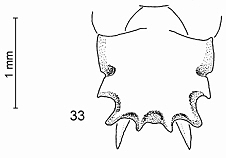Meranoplus discalis
| Meranoplus discalis | |
|---|---|

| |
| Scientific classification | |
| Kingdom: | Animalia |
| Phylum: | Arthropoda |
| Class: | Insecta |
| Order: | Hymenoptera |
| Family: | Formicidae |
| Subfamily: | Myrmicinae |
| Tribe: | Crematogastrini |
| Genus: | Meranoplus |
| Species: | M. discalis |
| Binomial name | |
| Meranoplus discalis Schödl, 2007 | |
Only known from the type locality, Cape York, Queensland.
Identification
Schödl (2007) - The paratypes resemble the holotype in all features. The characteristic clypeal structure separates M. discalis from all other related forms.
Keys including this Species
Distribution
Distribution based on Regional Taxon Lists
Australasian Region: Australia (type locality).
Distribution based on AntMaps
Distribution based on AntWeb specimens
Check data from AntWeb
Countries Occupied
| Number of countries occupied by this species based on AntWiki Regional Taxon Lists. In general, fewer countries occupied indicates a narrower range, while more countries indicates a more widespread species. |

|
Estimated Abundance
| Relative abundance based on number of AntMaps records per species (this species within the purple bar). Fewer records (to the left) indicates a less abundant/encountered species while more records (to the right) indicates more abundant/encountered species. |

|
Biology
Castes
Worker

| |
| . | |
Nomenclature
The following information is derived from Barry Bolton's Online Catalogue of the Ants of the World.
- discalis. Meranoplus discalis Schödl, 2007: 385, figs. 32, 33, 68, 86 (w.) AUSTRALIA (Queensland).
- Type-material: holotype worker, 2 paratype workers.
- Type-locality: holotype Australia: Queensland, 8-18 mi. NW Silver Plains, Cape York, v.-vi.1958, gum forest (Darlingtons); paratypes with same data.
- Type-depositories: MCZC (holotype); MCZC, NHMW (paratypes).
- Distribution: Australia.
Unless otherwise noted the text for the remainder of this section is reported from the publication that includes the original description.
Description
Worker
Holotype. TL 5.40, HL 1.35, HW 1.46, FC 1.18, CS 1.41, SL 0.73, SI1 50, SI2 52, PML 1.08, PW 1.30, PMD 1.50, PMI2 115, ML 1.20, PTLL 0.39, PTLH 0.60, PTDW 0.51, PPLL 0.38, PPLH 0.38, PPI 67, PPDW 0.51, PT/PP 100.
Mandible with four blunt teeth. In full face view the clypeal projection a truncated flat to feebly vaulted shelve, not exceeding anterolateral frontal corners, with a sinuate anterior margin. Head only moderately wider than long (CI 108), preoccipital margin shallowly concave. Frontal carinae, distinctly sinuately narrowed towards clypeus (FI 124). Antennal scrobe in lateral view posteriorly surpassing middle of length of head, ending far before posterior corners, transversely carinulate at rear, posteriorly well defined from preoccipital section. Genae and ventrolateral sides of head carinate, preoccipital lobes reticulate to foveo-reticulate. Eyes of moderate size (EL 0.25, REL 0.19, with 14 ommatidia in the longest row), situated in front of middle of lateral sides of head. Head in posterior half distinctly reticulate, in between ridges of rugo-reticulation smooth and glossy.
Promesonotal shield wider than long (PMI 121), moderately vaulted; its surface coarsely and irregularly rugose to rugoreticulate, the meshes somewhat longitudinally orientated; both lateral sides and rear broadly translucently margined, posterolateral projections well developed, arcuately directed outwards, posterior projections short and triangular. Propodeal declivity overhung by mesonotal hind margin. Propodeal spines moderate in length related to body size (PSL 0.50) situated above middle of length of declivity, massive and straight and moderately diverging in dorsal view.
Petiole in lateral view distinctly higher than long (PTI 65), narrowly triangular with anterior face straight, meeting posterior face in an acute angle. Postpetiole elongately nodiform with a small anterio-basal tooth.
Gaster entirely microreticulate with glossy spots around hair pits. Surface covered with evenly distributed pilosity exsiting of shorter decumbent and longer more or less erect arcuate stiff hairs.
Distinctly bicolored with gaster and appendages ferrugineous and remainder of body piceous.
Paratype (n = 2). TL 4.95-5.25, HL 1.28-1.33, HW 1.30-1.40, FC 1.08-1.13, FI 121-124, CI 102-106, CS 1.29-1.36, SL 0.68-0.72, SI1 51-52, SI2 52-53, PML 0.95-1.05, PW 1.18-1.28, PMI 121-124, PMD 1.35-1.48, PMI2 115-116, ML 1.15-1.20, PSL 0.45-0.48, PTLL 0.35-0.38, PTLH 0.54-0.58, PTI 65, PTDW 0.46-0.49, PPLL 0.33-0.35, PPLH 0.53-0.55, PPI 62-64, PPDW 0.48-0.50, PT/PP 97-98, EL 0.23-0.24, REL 0.18, with 11-13 ommatidia in the longest row.
Type Material
Holotype worker, Queensland: 8-18 mi N.W. of \ Silver Plains Cape York, Q. May-June '58 Darlingtons\gum forest (Museum of Comparative Zoology). Paratypes. 2 workers, same data as holotype (MCZC, Naturhistorisches Museum Wien, Vienna).
Etymology
The name refers to the flat clypeal projection.
References
- Schödl, S. 2007. Revision of Australian Meranoplus: the Meranoplus diversus group. Memoirs of the American Entomological Institute. 80:370-424.
